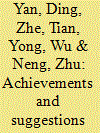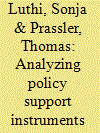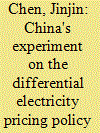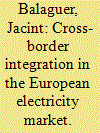|
|
|
Sort Order |
|
|
|
Items / Page
|
|
|
|
|
|
|
| Srl | Item |
| 1 |
ID:
109430


|
|
|
|
|
| Publication |
2011.
|
| Summary/Abstract |
An agent-based computational laboratory for exploratory energy policy by means of controlled computational experiments is proposed. It is termed the ACEGES (agent-based computational economics of the global energy system). In particular, it is shown how agent-based modelling and simulation can be applied to understand better the challenging outlook for oil production by accounting for uncertainties in resource estimates, demand growth, production growth and peak/decline point. The approach emphasises the idea that the oil system is better modelled not as black-box abode of 'the invisible hand' but as a complex system whose macroscopic explananda emerges from the interactions of its constituent components. Given the estimated volumes of oil originally present before any extraction, simulations show that on average the world peak of crude oil production may happen in the broad vicinity of the time region between 2008 and 2027. Using the proposed petroleum market diversity, the market diversity weakness rapidly towards the peak year.
|
|
|
|
|
|
|
|
|
|
|
|
|
|
|
|
| 2 |
ID:
109311


|
|
|
|
|
| Publication |
2011.
|
| Summary/Abstract |
In order to promote energy efficiency and emission reduction, the importance of improving building energy efficiency received sufficient attention from Chinese Government. The heat metering and energy efficiency retrofit for existing residential buildings of 0.15 billion m2 in northern heating regions of China was initiated in 2007 and completed successfully at the end of 2010. This article introduced the background and outline of the retrofit project during the period of 11th five-year plan. Numerous achievements that received by retrofit such as environmental protection effect, improvement of indoor environment, improvement of heating system, investment guidance effect, promotion of relevant industries and increasing chances of employment were concluded. Valuable experience that acquired from the retrofit project during the period of 11th five-year plan was also summarized in this article. By analyzing the main problems emerged in the past, pertinent suggestions were put forward to promote a larger scale and more efficient retrofit project in the period of 12th five-year plan.
|
|
|
|
|
|
|
|
|
|
|
|
|
|
|
|
| 3 |
ID:
109336


|
|
|
|
|
| Publication |
2011.
|
| Summary/Abstract |
A transition to a renewable energy system is high on the policy agenda in many countries. A promising energy source for a low-carbon energy future is wind. Policy-makers can attract wind energy development by providing attractive policy frameworks. This paper argues that apart from the level of financial support, both the risks stemming from the regulatory environment (legal security, administrative process and grid access) and the ability to finance projects play a critical role in determining the attractiveness of the development environment. It sheds light on how project developers trade off these different aspects and to what extent the attractiveness of a certain policy framework increases with the introduction of specific measures. Conjoint analysis is employed to provide empirical evidence on the preference of wind energy developers in the EU and the US. The analysis shows that developers' preferences are very similar across the studied regions and for different types of developers. Which policy measures could be most valuable depends on the specific existing environment. In some southeastern European countries, a reduction of administrative process duration may yield the highest utility gains, whereas, in the US, improvements in grid access regulation and an increase in remuneration levels may be more effective.
|
|
|
|
|
|
|
|
|
|
|
|
|
|
|
|
| 4 |
ID:
109352


|
|
|
|
|
| Publication |
2011.
|
| Summary/Abstract |
It is increasingly recognised that GHG reduction policies can have important ancillary benefits in the form of positive local and regional environmental impacts. The purpose of this paper is to estimate the domestic ancillary pollution benefits of climate policy in Sweden, and investigate how these are affected by different climate policy designs. The latter differ primarily in terms of how the country chooses to meet a specific target and where the necessary emission reductions take place. The analysis relies on simulations within the energy system optimisation model TIMES-Sweden, and focuses on four non-GHG pollutants: Nitrogen Oxides (NOX), Non Methane Volatile Organic Compounds (NMVOC), inhalable particles (PM2.5), and Sulphur dioxide (SO2). The simulations permit detailed assessments of the respective technology and fuel choices that underlie any net changes in the estimated ancillary effects. The results indicate that the ancillary benefits constitute a far from insignificant share of total system costs, and this share appears to be highest in the scenarios that entail the largest emission reductions domestically. This result reflects the fact that carbon dioxide emission reductions abroad also implies a lost opportunity of achieving substantial domestic welfare gain from the reductions of regional and local environmental pollutants.
|
|
|
|
|
|
|
|
|
|
|
|
|
|
|
|
| 5 |
ID:
109316


|
|
|
|
|
| Publication |
2011.
|
| Summary/Abstract |
Using a panel data over 50 US states and years 1991-2007, this paper uses a state fixed-effects model with state-specific time-trends to estimate the effects of state policies on the penetration of various emerging renewable electricity sources, including wind, biomass, geothermal, and solar photovoltaic. Renewable portfolio standards with either capacity or sales requirements have a significant impact on the penetration of all types of renewables-however, this impact is variable depending on the type of renewable source: it is negative for combined renewables, wind, and biomass; and positive for geothermal and solar. Further, clean energy funds and required green power options mostly result in increasing the penetration of all types of renewables. On the other hand, voluntary renewable portfolio standards as well as state green power purchasing programs are found to be ineffective in increasing the penetration of any type of renewable source. Finally, economic variables, such as electricity price, natural gas price, and per capita GDP as well as structural variables, such as league of conservation voters rating and the share of coal-generated electricity are found to be generally insignificant, suggesting the crucial role of policy in increasing the penetration of renewables.
|
|
|
|
|
|
|
|
|
|
|
|
|
|
|
|
| 6 |
ID:
109319


|
|
|
|
|
| Publication |
2011.
|
| Summary/Abstract |
Welfare analyses of energy taxes typically show that systems with uniform rates perform better than differentiated systems. However, most western countries include some exemptions for their energy-intensive export industries and thereby avoid this potential welfare gain. Böhringer and Rutherford (1997) find that uniform taxation of carbon emissions in combination with a wage subsidy preserves jobs in these industries at a lower welfare cost compared with a differentiated system. The wage subsidy scheme generates a substantial welfare gain per job saved. This study, however, finds that welfare costs are substantial when less accurate policy measures, represented by production-dependent subsidies, protect jobs in Norwegian electricity-intensive industries. The welfare cost per job preserved by this subsidy scheme amounts to approximately 60% of the wage cost per job, suggesting that these jobs are expensive to preserve. A uniform electricity tax combined with production-dependent subsidies preserves jobs at a lower welfare cost compared with the current differentiated electricity tax system.
|
|
|
|
|
|
|
|
|
|
|
|
|
|
|
|
| 7 |
ID:
109331


|
|
|
|
|
| Publication |
2011.
|
| Summary/Abstract |
Using a case-study, inductive, narrative approach, this article explores the history, drivers, benefits, and barriers to the Bakun Hydroelectric Project in East Malaysia. Situated on the island of Borneo, Bakun Dam is a 204 m high concrete face, rock filled dam on the Balui River in the Upper Rajang Basin in the rainforests of Sarawak. Bakun Dam and its affiliated infrastructure could be the single largest and most expensive energy project ever undertaken in Southeast Asia. Based on data collected through site visits, original field research in Sarawak, and more than 80 research interviews, the article begins by teasing out the complex history and drivers behind the Bakun project before identifying a set of potential social, political, and economic benefits the project could deliver. It then delves into six sets of barriers in the technical, economic, political, legal and regulatory, social, and environmental realms. We find that Bakun illustrates how centralized energy megaprojects, while ostensibly championed for reasons of economies of scale and the ability to bring about transformational change in the shortest period of time, often fail to address broader development goals such as fighting energy poverty and improving the livelihoods of the local communities they are supposed to serve.
|
|
|
|
|
|
|
|
|
|
|
|
|
|
|
|
| 8 |
ID:
109321


|
|
|
|
|
| Publication |
2011.
|
| Summary/Abstract |
The development of urbanization is accelerating in China, and there are great pressures and opportunities in cities to reduce carbon emissions. An emissions inventory is a basic requirement for analyzing emissions of greenhouse gases (GHGs), their potential reduction and to realize low-carbon development of cities. This study describes a method to establish a GHGs emissions inventory in Chinese cities for 6 emission sources including industrial energy consumption, transportation, household energy consumption, commercial energy consumption, industrial processes and waste. Nanjing city was selected as a representative case to analyze the characteristics of carbon emissions in Chinese cities. The results show that carbon emissions in Nanjing have increased nearly 50% during the last decade. The three largest GHGs contributors were industrial energy consumption, industrial processes and transportation, which contributed 37-44%, 35-40% and 6-10%, respectively, to the total GHGs emissions. Per GDP carbon emissions decreased by 55% from 2002 to 2009, and the per capita and per GDP carbon emissions were comparable or even lower than the world average levels. These results have important policy implications for Chinese cities to control their carbon emissions.
|
|
|
|
|
|
|
|
|
|
|
|
|
|
|
|
| 9 |
ID:
109393


|
|
|
|
|
| Publication |
2011.
|
| Summary/Abstract |
This paper investigates methodologies to quantify CO2 emissions from cars and light trucks in Florida. The most widely used methodology to calculate greenhouse gas emissions in the transportation sector at the local level uses a harmonic average (HA) methodology based on nationally averaged fuel economies that assume 55% city and 45% highway VMTs. This paper presents a local condition (LC) methodology that accounts for county-level variations in city and highway VMTs, as opposed to assumed uniform driving conditions. Both HA and LC methodologies were used to estimate and compare absolute and per capita CO2 emissions both statewide and counties for 2000 and 2008. From 2000 to 2008, statewide absolute and per capita CO2 emissions increased similarly using HA and LC methodologies; however, the percent change varied considerably among counties. Statewide CO2 emissions calculated from HA and LC methodologies differed by only -0.2% (2000) and 1.7% (2008); however, the differences in the county-level emissions ranged from -8.0% to 14.9% (2000) and from -5.6% to 17.0% (2008). While either the HA or the LC methodology yields a similar result statewide, significant variation exists at the county level, warranting the need to consider local driving conditions when estimating county-level emissions.
|
|
|
|
|
|
|
|
|
|
|
|
|
|
|
|
| 10 |
ID:
109418


|
|
|
|
|
| Publication |
2011.
|
| Summary/Abstract |
This study asks whether sub-national inequalities in carbon dioxide (CO2) emissions mirror international patterns in carbon inequality using the case study of China. Several studies have examined global-level carbon inequality; however, such approaches have not been used on a sub-national scale. This study examines inter-provincial inequality in CO2 emissions within China using common measures of inequality (coefficient of variation, Gini Index, Theil Index) to analyze provincial-level data derived from the IPCC reference approach for the years 1997-2007. It decomposes CO2 emissions inequality into its inter-regional and intra-regional components. Patterns of per capita CO2 emissions inequality in China appear superficially similar to, though slightly lower than, per capita income inequality. However, decomposing these inequalities reveals different patterns. While inter-provincial income inequality is highly regional in character, inter-provincial CO2 emissions inequality is primarily intra-regional. While apparently similar, global patterns in CO2 emissions are not mirrored at the sub-national scale.
|
|
|
|
|
|
|
|
|
|
|
|
|
|
|
|
| 11 |
ID:
109361


|
|
|
|
|
| Publication |
2011.
|
| Summary/Abstract |
The UK Government plans a capacity mechanism to ensure sufficient reserves as the share of intermittent generation increases. This article reviews the use of last resort capacity mechanisms in two other energy-only markets, Australia and New Zealand.
The Australian National Electricity Market has infrequent price spikes up to A$12,500 (£7800)/MWh. Option contracts have supported significant investment in peak capacity. The system operator also has an ability to contract reserve up to 9 months before projected shortfalls. Reserve has been contracted on two occasions but never dispatched.
The New Zealand electricity market includes a reserve energy scheme which allows the system operator to contract and dispatch reserve capacity. One plant has been contracted under the scheme. The plant is currently offered into the market at NZ$5000 (£2300)/MWh.
In both markets there have been concerns that reserve schemes could reduce the frequency of high prices and damage price signals for peak investment. Following a Ministerial review in 2009 the New Zealand scheme is being closed down and the plant is for sale. The Australian scheme is to be closed down in 2013. This experience raises concerns about the possible impact of a new capacity mechanism in Great Britain.
|
|
|
|
|
|
|
|
|
|
|
|
|
|
|
|
| 12 |
ID:
109375


|
|
|
|
|
| Publication |
2011.
|
| Summary/Abstract |
This article draws attention to problems important for all EU power consumers-the unfairness in individual payments for power transmission and in the cross-border subsidy element in the mechanism of Inter-Transmission System Operators (TSO) Compensation (ITC). A brief review of power transmission tariffs brings out the structure of the problems. A short retrospection explains their growth. The essence of the ITC mechanism is explained and existing shortcomings are illustrated. The deficiencies of existing regulations for transmission pricing are analyzed. In the light of this analysis, the ITC problem is reconsidered and defined more precisely. The basic prerequisites to an ITC reformulation process are presented. The main principles of a new simple, transparent and equitable approach are suggested, in accordance with the contemporary legal positions and functions of the TSOs.
|
|
|
|
|
|
|
|
|
|
|
|
|
|
|
|
| 13 |
ID:
109390


|
|
|
|
|
| Publication |
2011.
|
| Summary/Abstract |
This paper's objective is to apply Intervention Mapping, a planning process for the systematic development of theory- and evidence-based health promotion interventions, to the development of interventions to promote energy conservation behavior. Intervention Mapping (IM) consists of six steps: needs assessment, program objectives, methods and applications, program development, planning for program implementation, and planning for program evaluation. Examples from the energy conservation field are provided to illustrate the activities associated with these steps. It is concluded that applying IM in the energy conservation field may help the development of effective behavior change interventions, and thus develop a domain specific knowledge-base for effective intervention design.
|
|
|
|
|
|
|
|
|
|
|
|
|
|
|
|
| 14 |
ID:
109359


|
|
|
|
|
| Publication |
2011.
|
| Summary/Abstract |
Differential electricity pricing was promulgated by China's central government to guide the development of high energy-consuming industries, which are significant for energy conservation. This paper examines the twists and turns of the policy implementation at the provincial level, and seeks to elucidate the difficulties in its implementation. Local governments, concerned that following the central directives would hurt local interests, have tried to deviate from the central orders while the central revises the policy from time to time to ensure local compliance. Three difficulties are analyzed: (1) the current relations between the central and local energy regulatory institutions make these local institutions difficult to perform their duties, and affect incentives for local governments to respond to central directives; (2) financial reform puts a great burden on local governments to raise revenues to cover expenditures, making local governments focus mainly on economic development rather than serving merely as political agents of the central government; (3) the aggressive attitude of local governments in pursuing GDP growth is not necessarily driven by the central government, but by pressure from competition among localities and the need to win local support. Solving these difficulties is important for making national energy conservation polices effective and efficient.
|
|
|
|
|
|
|
|
|
|
|
|
|
|
|
|
| 15 |
ID:
109344


|
|
|
|
|
| Publication |
2011.
|
| Summary/Abstract |
In response to the ongoing climate policy debates, this study examines the cost impacts of carbon-pricing legislation on selected US energy-intensive manufacturing industries. Specifically, it evaluates output-based rebate measures and the border adjustment provision specified in the bill, and tests the effectiveness of cost containment features of the policy, such as the international offsets, under various market assumptions. Results of the examination confirm that in all policy cases or industries, the output-based rebates would effectively mitigate the manufacturers' carbon-pricing costs in the short-to-medium term. However as the rebates decline after 2020, especially in a case where low-carbon electricity generation or international offsets are not readily available or implemented, these industries would suffer greater declines in profitability. At the same time, the study's findings were mixed concerning the effectiveness of the border adjustment measure in reducing cost impacts after 2020. While border adjustments could reduce costs to US manufacturing sectors, at least temporarily, they could create problems for domestic downstream producers and exports, under cost pass-along conditions. However at best, the output-based rebates, international offset, and border adjustment and measures primarily buy time for manufacturers. The only long-term solution is for EITE industries to invest in energy-saving and next-generation low-carbon technologies.
|
|
|
|
|
|
|
|
|
|
|
|
|
|
|
|
| 16 |
ID:
109334


|
|
|
|
|
| Publication |
2011.
|
| Summary/Abstract |
This paper examines the causal relationships between carbon dioxide emissions, energy consumption and real economic output using panel cointegration and panel vector error correction modeling techniques based on the panel data for 28 provinces in China over the period 1995-2007. Our empirical results show that CO2 emissions, energy consumption and economic growth have appeared to be cointegrated. Moreover, there exists bidirectional causality between CO2 emissions and energy consumption, and also between energy consumption and economic growth. It has also been found that energy consumption and economic growth are the long-run causes for CO2 emissions and CO2 emissions and economic growth are the long-run causes for energy consumption. The results indicate that China's CO2 emissions will not decrease in a long period of time and reducing CO2 emissions may handicap China's economic growth to some degree. Some policy implications of the empirical results have finally been proposed.
|
|
|
|
|
|
|
|
|
|
|
|
|
|
|
|
| 17 |
ID:
109437


|
|
|
|
|
| Publication |
2011.
|
| Summary/Abstract |
The first aim of this paper is to shed light on the thermodynamic reasons for the practical pursuit of low temperature operation by engineers involved in the design and the operation of combined heat and power (CHP) and district heating (DH) systems. The paper shows that the steam cycle of a combined heat and power generator is thermodynamically equivalent to a conventional steam cycle generator plus an additional virtual steam cycle heat pump. This apparently novel conceptualisation leads directly to (i) the observed sensitivity of coefficient of performance of CHP to supply and return temperatures in associated DH systems, and (ii) the conclusion that the performance of CHP will tend to be significantly higher than real heat pumps operating at similar temperatures. The second aim, which is pursued more qualitatively, is to show that the thermodynamic performance advantages of CHP are consistent with the goal of deep, long-term decarbonisation of industrialised economies. As an example, estimates are presented, which suggest that CHP based on combined-cycle gas turbines with carbon capture and storage has the potential to reduce the carbon intensity of delivered heat by a factor of ~30, compared with a base case of natural gas-fired condensing boilers.
|
|
|
|
|
|
|
|
|
|
|
|
|
|
|
|
| 18 |
ID:
109345


|
|
|
|
|
| Publication |
2011.
|
| Summary/Abstract |
It has been argued by some that the substitution of biofuels for gasoline could increase greenhouse gas (GHG) emissions, rather than reduce them. The increase is attributed to the indirect land use change effects of planting new grain and corn crops around the world to replace those progressively being devoted to ethanol production. In this paper, indirect effects are minimised by allowing land to be used for both food and fuel, rather than for one or the other. We present a sugarcane 'feed+fuel' biorefinery, which produces bioethanol and yeast biomass, a source of single-cell protein (SCP), that can be used as a high-protein animal feed supplement. The yeast SCP can partially substitute for grass in the feed of cattle grazing on pasture and thereby potentially release land for increased sugarcane production, with minimal land use change effects. Applying the concept conservatively to the Brazilian ethanol and livestock industry our model demonstrates that it would be technically feasible to raise ethanol production threefold from the current level of 27 GL to over 92 GL. The extra ethanol would meet biofuel market mandates in the US without bringing any extra land into agricultural or pastoral use. The analysis demonstrates a viable way to increase biofuel and food production by linking two value chains as called for by industrial ecology studies.
|
|
|
|
|
|
|
|
|
|
|
|
|
|
|
|
| 19 |
ID:
109355


|
|
|
|
|
| Publication |
2011.
|
| Summary/Abstract |
A scientific debate is in progress about the intersection of climate change with the new field of fossil fuels depletion geology. Here, new projections of atmospheric CO2 concentration and global-mean temperature change are presented, should fossil fuels be exploited at a rate limited by geological availability only. The present work starts from the projections of fossil energy use, as obtained from ten independent sources. From such projections an upper bound, a lower bound and an ensemble mean profile for fossil CO2 emissions until 2200 are derived. Using the coupled gas-cycle/climate model MAGICC, the corresponding climatic projections out to 2200 are obtained. We find that CO2 concentration might increase up to about 480 ppm (445-540 ppm), while the global-mean temperature increase w.r.t. 2000 might reach 1.2 °C (0.9-1.6 °C). However, future improvements of fossil fuels recovery and discoveries of new resources might lead to higher emissions; hence our climatic projections are likely to be underestimated. In the absence of actions of emissions reduction, a level of dangerous anthropogenic interference with the climate system might be already experienced toward the middle of the 21st century, despite the constraints imposed by the exhaustion of fossil fuels.
|
|
|
|
|
|
|
|
|
|
|
|
|
|
|
|
| 20 |
ID:
109314


|
|
|
|
|
| Publication |
2011.
|
| Summary/Abstract |
This paper examines the electricity market integration process in two European areas based on the pricing behavior of Norwegian and Swiss exporters. The aim is to gain evidence for the period after the adoption of the "Second Legislative Package" (2003). The pricing behavior of Norwegian exporters indicates that the wholesale markets for Denmark and Sweden are highly integrated. Moreover, results are fully compatible with the existence of a very competitive marketplace for electricity. This clearly contrasts with the evidence provided by Swiss exporters. In this last case, analysis revealed differences in pricing-to-market behavior between Italy, France and Germany, which indicates that exporters take advantage of international market segmentation and divergences between market structures. This outcome provides a reasonable explanation as to why price differences between countries cannot be fully attributed to transmission costs, as has been claimed in previous research. We also found cross-country convergence in levels of markups and in pricing-to-market behavior of the Swiss exporters for the first part of the period that was analyzed. The evidence is fully consistent with an initial impulse toward market integration originated by reforms implemented at the beginning of the last decade.
|
|
|
|
|
|
|
|
|
|
|
|
|
|
|
|
|
|
|
|
|